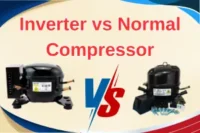Advantages and Drawbacks of Built-In Refrigerators Explained
Published: 14 Jan 2025
Built-in refrigerators are the go-to choice for sleek and modern kitchens, blending effortlessly into cabinetry for a flawless look. They promise to transform your space, offering both luxury and practicality. But are they as perfect as they seem? The advantages and disadvantages of built-in refrigerators might surprise you. And we discuss in detail the good and bad aspects of this together with you.
Are you ready? Let’s move on to our article without wasting our time. Let’s get started.
Advantages of Built-in Refrigerators
Built-in refrigerators are known for their sleek design and ability to blend seamlessly into modern kitchens. They bring a touch of elegance while offering practical features for daily use. Let’s explore the key benefits of Built-in refrigerators.
So are you ready? We have hidden the list of the most important points for you, just for you. So let’s see it together.
Comprehensive List of Pros for Built-in Refrigerators
- Seamless Design Integration
- Maximized Space Efficiency
- Unmatched Durability
- Premium Construction
- Custom Sizes and Styles
- Advanced Technology
- Eco-Friendly Performance
- Better Storage Options
- Stylish Finishes
- Higher Resale Value
- Quieter Operation
- Modular Configurations
- Improved Kitchen Flow
- Streamlined Aesthetics
- Cost-Effective in the Long Run
Hey, now we are going to discuss each point with you in detail. Are you ready? Let’s see.
1. Seamless Design Integration
- Blends perfectly with kitchen cabinets.
- Gives a sleek and stylish look to the kitchen.
- Looks more like furniture than an appliance.
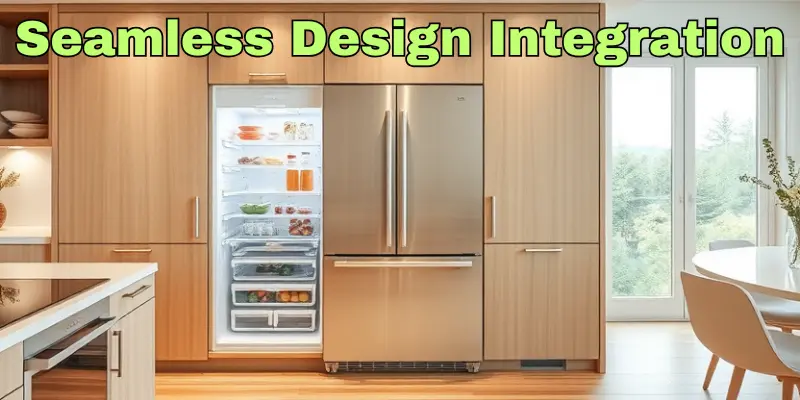
2. Maximized Space Efficiency
- Fits flush with cabinets, leaving no gaps.
- Perfect for small or compact kitchens.
- Helps in organizing the space better.
3. Unmatched Durability
- Built to last much longer than regular fridges.
- Uses higher-quality parts and materials.
- Designed for long-term performance.
4. Premium Construction
- Sturdy shelves and bins that hold heavy items.
- Interior parts are made from top-notch materials.
- Feels solid and dependable when you use it.
5. Custom Sizes and Styles
- Available in different shapes and sizes.
- You can pick what suits your kitchen best.
- Offers flexibility for unique designs or spaces.
6. Advanced Technology
- Offers features like precise temperature control.
- Many models are smart and connect to your devices.
- Keeps food fresh for a longer time.
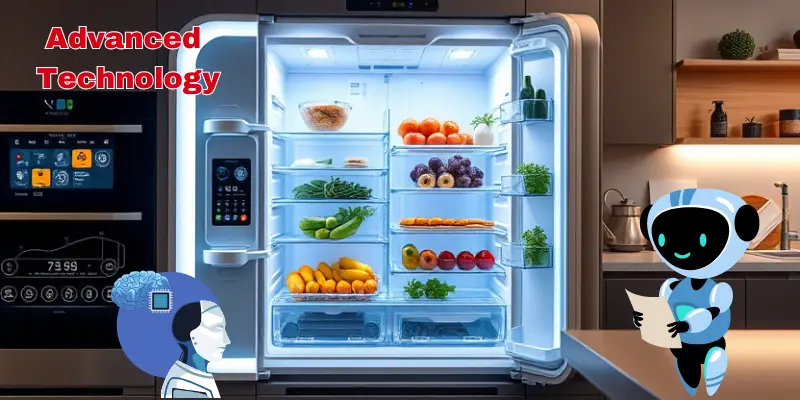
7. Eco-Friendly Performance
- Most models are ENERGY STAR certified.
- Saves electricity, lowering your power bills.
- Supports eco-conscious living.
8. Better Storage Options
- Adjustable shelves for customized storage.
- Wide compartments for easier organization.
- Some models include special zones for wine or fresh produce.
9. Stylish Finishes
- Choose stainless steel for a timeless look.
- Add custom panels to match your cabinetry.
- Makes your kitchen look more polished.
10. Higher Resale Value
- Adds value to your home for future buyers.
- High-end appliances attract more attention in the market.
- Often considered a luxury feature.
11. Quieter Operation
- Produces very little noise when running.
- Keeps the kitchen calm and peaceful.
- Suitable for open-concept layouts.
12. Modular Configurations
- Allows you to separate refrigerator and freezer units.
- Offers flexibility in arranging your kitchen.
- Ideal for customized or unconventional layouts.
13. Improved Kitchen Flow
- Built to fit naturally into your workspace.
- Enhances cooking and organizing efficiency.
- Makes the kitchen feel more organized.
14. Streamlined Aesthetics
- Keeps the kitchen looking tidy and professional.
- Avoids the bulky look of standard refrigerators.
- Adds a touch of luxury to the space.
15. Cost-Effective in the Long Run
- Saves on frequent repairs or replacements.
- High durability reduces long-term expenses.
- A wise investment for decades of use.

After exploring the many advantages of a built-in refrigerator, you’re probably wondering about the other side of the coin. Don’t worry—we’ve prepared a clear breakdown of its disadvantages for you. Let’s move to the next section to learn more.
Are you ready? Let’s see.
Disadvantages of Built-in Refrigerators
As much as built-in refrigerators can add style and convenience to your kitchen, they also come with a few things to keep in mind. It’s essential to know these details before making your choice. Let’s explore the limitations of built-in fridges.
List of 10 Cons of Built-in Refrigerators
- High Initial Cost
- Expensive Installation
- Limited Size Options
- Lower Storage Capacity
- Complex Maintenance and Repairs
- Difficult to Relocate
- Limited Customization for Smaller Kitchens
- Potentially High Energy Consumption
- Limited Models for Certain Kitchen Designs
- Longer Lead Time for Installation
Hey, now we’ll discuss each negative aspect in detail, so are you ready? Let’s see.
1. High Initial Cost
- Built-in refrigerators can be much more expensive to buy than standard models.
- You’ll pay a premium for the design, features, and materials.
- In addition to the fridge price, you may need to buy extra items, like custom panels.
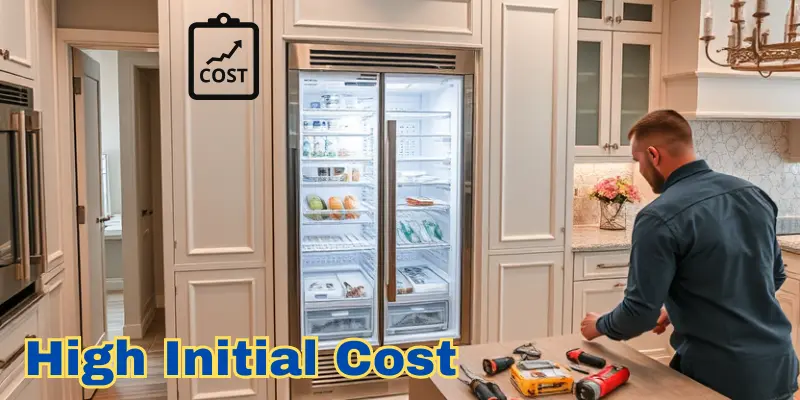
2. Expensive Installation
- These refrigerators often require professional installation, which can add to the overall cost.
- You might have to adjust your kitchen cabinetry to make space for the fridge.
- The process can take longer compared to installing a regular fridge.
3. Limited Size Options
- Built-in refrigerators come in fewer sizes than regular ones, making them less flexible.
- If your kitchen has limited space, it may be hard to find a fridge that fits perfectly.
- Larger built-in models might not suit smaller kitchens.
4. Lower Storage Capacity
- Built-in refrigerators are designed to fit neatly into your kitchen, but that means they often have less storage space.
- They may not have as much room for groceries compared to freestanding models.
- You may need to organize more carefully to fit all your items.
5. Complex Maintenance and Repairs
- Repairs might be trickier and more expensive since built-in models often need to be removed to fix them.
- Finding a repair person with the right expertise could take time.
- Parts for built-in refrigerators can be harder to find and more costly.
6. Difficult to Relocate
- Once installed, built-in refrigerators are hard to move because they’re fixed into your kitchen design.
- If you move to a new home, the fridge will likely stay in place, making it less portable.
- This is a big downside if you like rearranging or updating your kitchen frequently.
7. Limited Customization for Smaller Kitchens
- Smaller kitchens might not leave enough space for a built-in fridge or may require modifications to the existing layout.
- Built-in fridges can take up valuable cupboard or counter space.
- Fitting them in may involve extra costs for kitchen redesigns.
8. Potentially High Energy Consumption
- Some built-in fridges may use more power, especially older models.
- You need to check if it’s Energy Star certified to ensure better efficiency.
- Higher energy consumption can lead to higher utility bills in the long run.
9. Limited Models for Certain Kitchen Designs
- Some built-in refrigerators might not match your kitchen’s specific design, limiting choices.
- If you’re looking for certain features or styles, the options could be fewer.
- Certain kitchen layouts may require custom-built fridges, which cost more.
10. Longer Lead Time for Installation
- If you order a built-in refrigerator, it might take longer to arrive and get installed.
- The process involves scheduling, delivery, and customization, which can delay your plans.
- You might need to wait for some time before the fridge is ready to use.
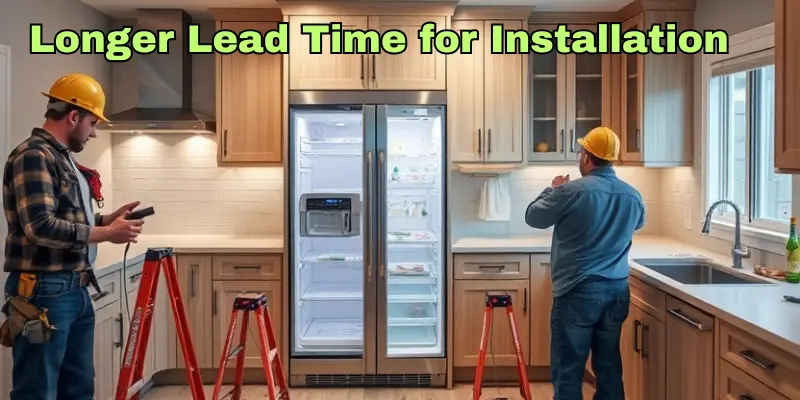
Hey guys, now that we have discussed the pros and cons of a built-in refrigerator in detail and you’ve got all the information if you’re still unsure about what to decide, don’t worry! We’ve got a special bonus solution to help you make your final decision. Let’s check it out in the next section!
Final words for built-in refrigerators
So guys, in this article, we’ve covered the advantages and disadvantages of built-in refrigerators in detail. While they offer incredible style, efficiency, and durability, they do come with some downsides like the cost and installation complexity. If you’re after a long-lasting solution and don’t mind the investment, a built-in fridge could be worth it. Want to make the right choice? Take the next step and choose your perfect built-in refrigerator now!
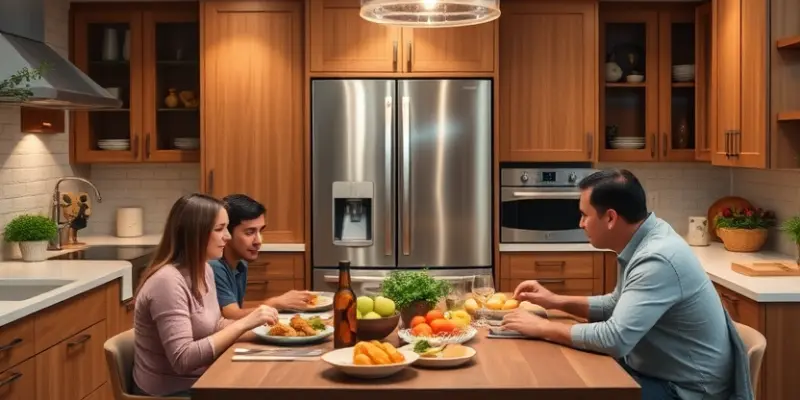
I know some more questions might be popping up in your head. But don’t worry! We have the perfect solutions ready for you. Let’s go over the common questions and their answers in the next section, and make everything clear!
Common Questions About Built-In Refrigerators
In this section, we’ve answered some of the most frequently asked questions about built-in refrigerators. Let’s first look at the list of these questions together.
- What makes a refrigerator built-in?
- How do you measure a built-in refrigerator?
- What is the advantage of a built-in refrigerator?
- Why do built-in refrigerators last longer?
- How long does a built-in fridge last?
- Why is a built-in fridge so expensive?
- How wide is a built-in fridge?
- What is the height of a built-in refrigerator?
- Can a built-in refrigerator be replaced with a regular fridge?
- Do built-in refrigerators save energy?
Hey guys, now we will discuss the answers to all the questions in detail.
A built-in refrigerator is specially made to fit perfectly into your kitchen cabinets. It’s not bulky or standing out; it fits flush with the cabinetry for a sleek, built-in look.
To measure a built-in refrigerator, you need to check the space where you want to put it. Measure the width, height, and depth carefully to make sure it will fit into the space properly.
Built-in refrigerators offer a clean, seamless look that makes your kitchen look neat. They fit snugly with the cabinets, which saves space and makes the kitchen feel bigger and more organized.
Built-in refrigerators are made with stronger materials and designed for long-term use. They’re built to handle wear and tear better than standard models, meaning they last longer.
A built-in fridge can last 15 to 20 years, or even longer with proper care. They are made to be very durable, so they have a longer lifespan than regular fridges.
Built-in refrigerators are more expensive because they’re designed to fit into your kitchen perfectly, and they use high-quality materials. They’re also more complicated to install, which adds to the cost.
The width of a built-in refrigerator can vary, but it is usually between 24 and 42 inches wide. You’ll need to choose a size based on the space you have in your kitchen.
The height of a built-in refrigerator is typically about 70 to 72 inches tall. This matches the height of most kitchen cabinets, allowing it to blend seamlessly.
Yes, but it might be a bit tricky. Built-in refrigerators are designed to fit in specific spaces, and a regular fridge may not fit perfectly or may stick out.
Yes, many built-in refrigerators are energy-efficient and come with an ENERGY STAR label. They use less electricity to keep things cool, which helps save money on your energy bills.
So, guys, it’s time to say goodbye.
We hope you enjoyed reading our article and found it helpful! If you still have any questions or thoughts, feel free to share them in the comments below—we’d love to hear from you. Also, don’t forget to check out our guide on the Advantages and Disadvantages of French Door Refrigerators for more insights. Explore our other articles to discover even more tips and advice!

- Be Respectful
- Stay Relevant
- Stay Positive
- True Feedback
- Encourage Discussion
- Avoid Spamming
- No Fake News
- Don't Copy-Paste
- No Personal Attacks

- Be Respectful
- Stay Relevant
- Stay Positive
- True Feedback
- Encourage Discussion
- Avoid Spamming
- No Fake News
- Don't Copy-Paste
- No Personal Attacks


